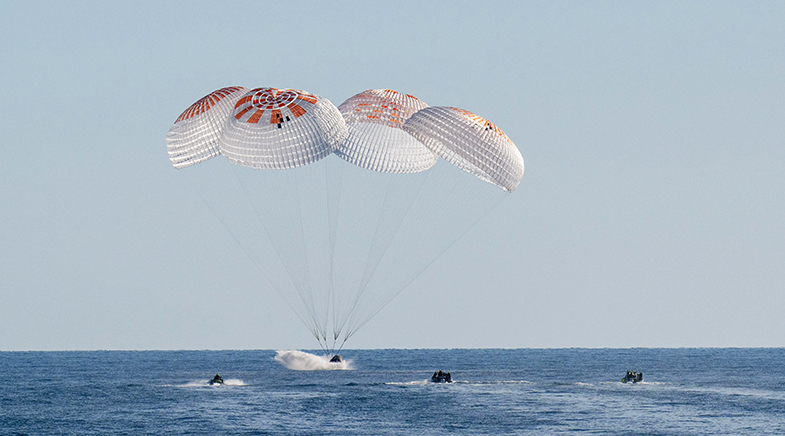A safe space
-
- from Shaastra :: vol 04 issue 03 :: Apr 2025

What space-faring nations can learn from NASA astronauts’ recent ordeal.
Early on March 18, 2025, Sunita Williams, Butch Wilmore and two colleagues from the International Space Station (ISS) splashed down off the Florida coast in a SpaceX-developed Crew Dragon craft. There was a sigh of relief from the well-wishers of Williams and Wilmore, and from space-faring nations and space enthusiasts. They were happy that this nine-month episode had a happy ending.
Not everyone was happy, though. Boeing, which was developing the Starliner crew capsule, was at the receiving end of criticism for failing to bring Starliner back to the operational level required to rescue the crew. The American public in general, too, was not happy about the monopoly created by SpaceX, whose Crew Dragon was the only reliable human transport system in the U.S. The programme of commercial crew transportation in the U.S. ended up having just one operational capsule. It is uncertain whether Boeing Starliner, SLS Orion or Blue Origin’s New Shepard will be operational in the near future.
Now, with renewed interest in human space travel, with Moon- and Mars-based economies at the centre stage, and proposals for private space stations in the offing, many nations and agencies are developing human transport modules. These include Russia, with its modern version of Soyuz MS; China, with its upgraded Shenzhou and Qingzhou; Europe with a Service Module; and India with the Gaganyaan programme. There are other private initiatives in Europe and Russia as well.
The lessons from the Williams-Wilmore and Boeing Starliner story are important in understanding the developmental challenges in such systems and approaches, to mitigate risks and provide safer journeys to astronauts and gaganyatris of the future. There were many reasons for the delay in ferrying back the astronauts who got stuck in the ISS. They went up in the Boeing Starliner, but the module had to come back empty since U.S. regulators were not confident of using it, in view of the anomalies until then. The verification tests done on the ground were not adequate to give them confidence. In fact, they brought out further issues with the design of Starliner and its safety margins. This raised concerns on the approval process for the maiden flight of the Starliner while it was showing signs of distress prior to the launch, though the anomalies were not in the same systems.
In this case, the ISS was used to keep the astronauts safe until an alternative craft was readied to bring them back. Imagine a situation of a maiden flight of a crew module where there is no capability to dock with the ISS, and in case of an anomaly, the only option would be to come back in the same craft, with its associated risks.
Planning a rescue mission using the Crew Dragon must have also faced technical difficulties, including the availability of appropriate pressure suits for astronauts, and scheduling a mission with its own associated commercial terms and conditions, as SpaceX is a competitor to Boeing in this business.
Unlike passenger aircraft, there are no generalised standards or certifications enforced through international agencies, applicable to human capsules going into outer space. Each design adopts its own systems; the qualification and certification requirements could be country- and agency-specific, and susceptible to political and business pressures. Interoperability of capsules is not generally addressed, including building common interfaces for docking as a standard, though the U.S. has a standard interface for others to adopt. Yet another issue is the unification of crew interfaces like suits and life-support systems which are essential when astronauts need to shift to another craft within a short time in an emergency.
The lessons from the Williams-Wilmore space adventure must be channelled to provide safer journeys to astronauts and gaganyatris of the future.
These recent events will have profound influence on the developers of human space capsules and transport systems in the future. Development of such modules is costly and has a long gestation time. They are also linked to some typical rockets for launch. In the future, fast-track developments are needed, and modules which can fly aboard many international rockets need to be developed.
An international body like the United Nations Committee on the Peaceful Uses of Outer Space, with its working groups, should adopt standards and measures to minimise crew risks in case of anomalies, and establish international support from other operators in case of emergency. It is heartening to note that many agencies are developing human space capsules, and that in a few years, there will be more choices to fly to space for leisure and exploration. This shows that the human race is not tied down to Earth by gravity, but is destined to be a multi-planet species one day. Williams and Wilmore are champions: they demonstrated resilience and courage by being part of the development of a new space module and taking part in the high-risk inaugural flight and also by surviving graciously under such extreme pressures of uncertainty and mission challenges.
Have a
story idea?
Tell us.
Do you have a recent research paper or an idea for a science/technology-themed article that you'd like to tell us about?
GET IN TOUCH















